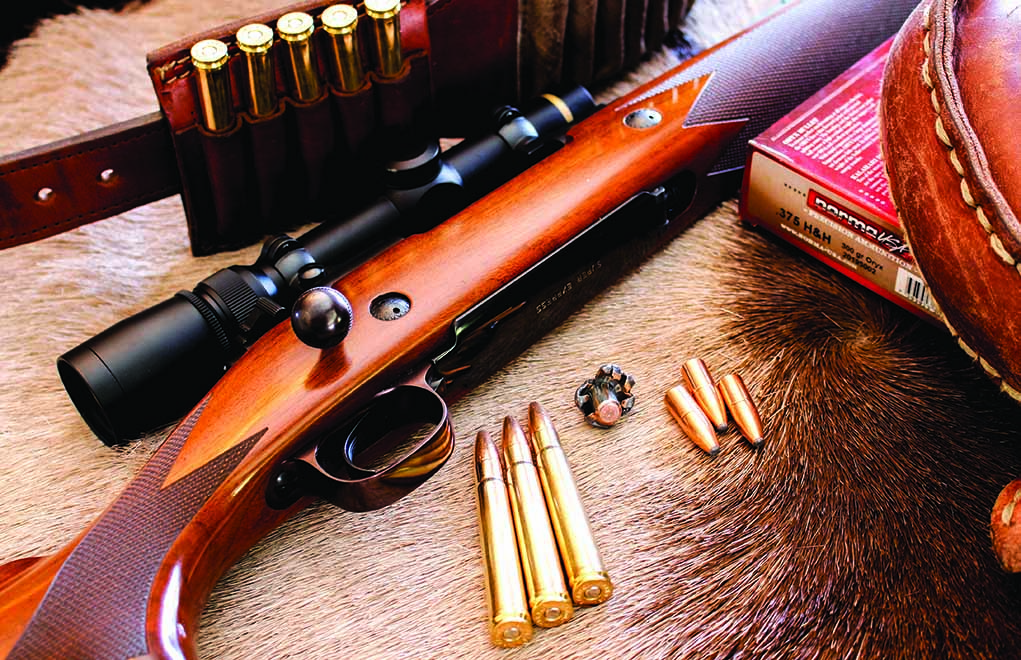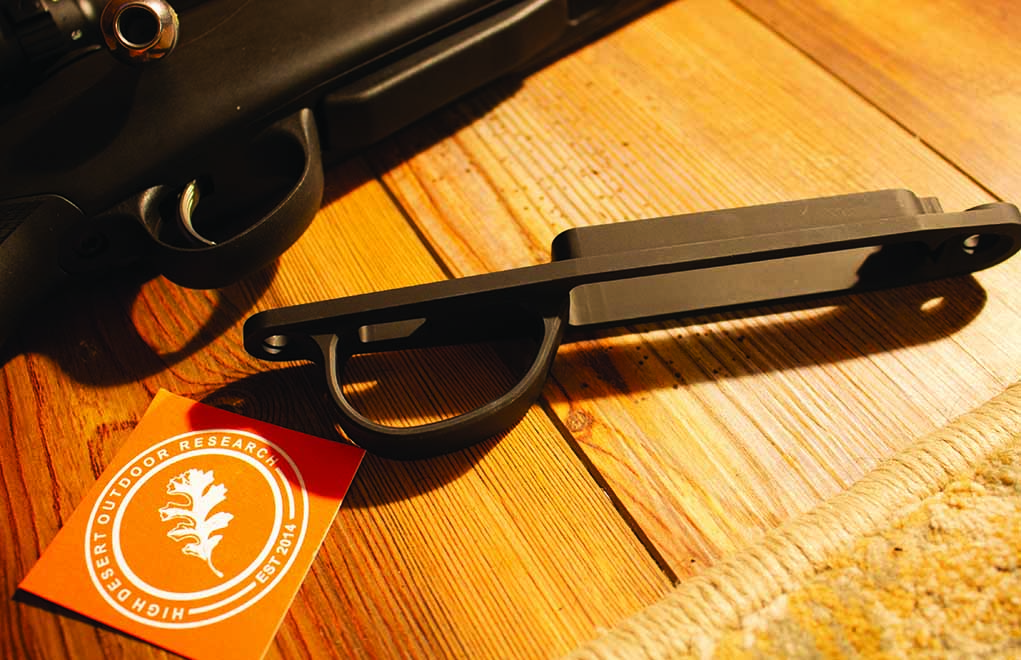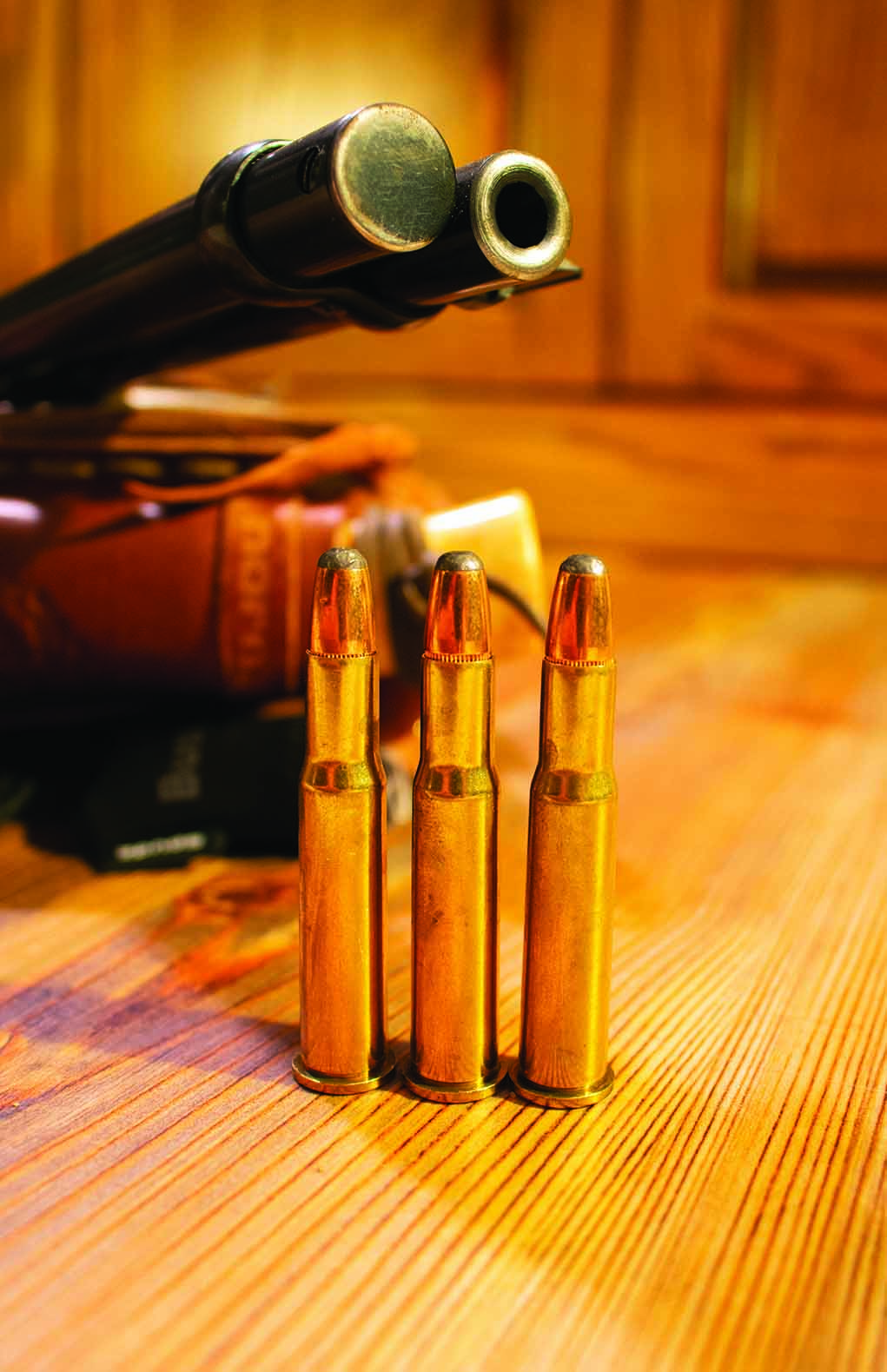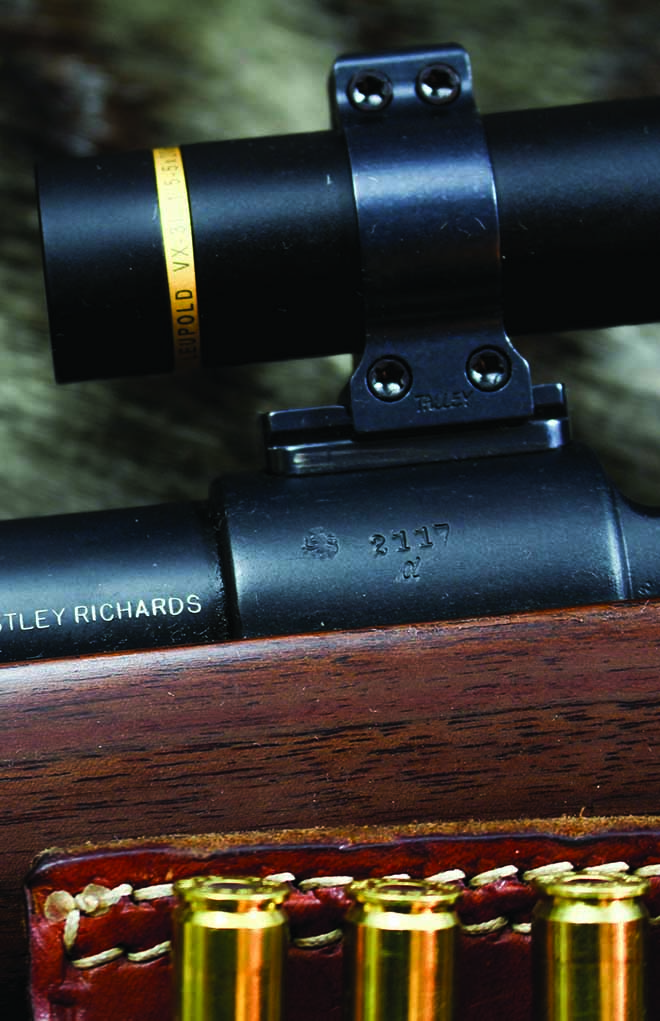
Do you have a bolt gun that doesn’t perform like it should? Here are five options to get your groups back in the bullseye.
How To Upgrade Your Bolt-Action Rifle:
It was my first big-bore rifle, and I was beyond excited to own it. It was a classic combination — a Winchester Model 70 in the undeniable .375 Holland & Holland Magnum — and when I headed to the range with several boxes of good ammunition, I was more excited than a kid on Christmas Eve.

Imagine my disappointment when I saw three-shot groups that measured between 2-3 inches at 100 yards.
I was immediately concerned that the recoil was too much for me — up to that point, the .308 Winchester was my main squeeze — so I asked Dad to shoot a few groups while I watched through the binocular to make sure the rifle was all good.
Dad’s first shot touched the edge of the bullseye at 2 o’clock, the second struck 3 inches up and to the right, and the third was within a half-inch of the first. Puzzled, I waited to see the second group, and I then noticed a pattern: The second of the three shots was always the flyer, and shots No. 1 and No. 3 were within an inch of each other.
Dad insisted the rifle wasn’t happy with the factory load ballistics, so we headed straight for the reloading bench. No matter the bullet weight, type, profile — no matter the primer or powder type or charge — I could not get the rifle to group within 2 inches.
I was near the end, and ready to proclaim the rifle as hopeless, when I made one last-ditch effort: I recalled an advertisement in the Safari Club magazine about a company in Texas who offered a problem-solving service.
On the phone with the good folks at Hill Country Rifles in New Braunfels, Texas, the gentleman on the other end cut me off halfway through the description of the problem and finished my sentence for me. It was like a weight had been lifted … and the problem wasn’t me after all.

“The Model 70s of that particular era were notorious for having this issue,” he said without hesitation. “It’s a relatively simple fix.”
What I had was a bedding problem, though I may never have known it without that phone call. That was almost 20 years ago, and I’ve learned an awful lot about the subtleties of bolt-action rifle issues. So, I’d like to address the issues I’ve been exposed to, and relate some experiences I’ve had, perhaps to help you recognize some potential problems and save you some grief.
The mechanics of a bolt-action rifle are not all that complex. Among the myriad of forms of repeating rifles, the bolt-action is among the simplest. Yet, the simplicity and strength leads us to expect the finest accuracy from the design. Let’s explore which fixes can be done at home, and which will require the services of a good gunsmith.
No. 1: Rifle Bedding
A rifle’s bedding can make or break the way it shoots. If the connection between the action and the stock isn’t solid, accuracy is most definitely going to suffer. A good gunsmith can see that your rifle’s action is properly bedded, making contact with the stock where it should, to keep things where they were meant to be.
More Gunsmithing Articles:
- Decoding The AR-10 Lower Receiver
- Performance AR: Build a Mk12 Mod 0
- How To Attach Your Suppressor
There are some at-home fixes, including epoxy kits that can fill and level the stock inlets, and I know many people who have solved a bedding problem at their own bench. Aluminum-pillar bedding is a means of providing metal-to-metal contact between the bottom metal and the action, via two aluminum pillars (betcha never saw that coming) that will surround the action screws. They can be set in epoxy in a wood stock once it has been drilled, though I personally feel the drilling is best left to a competent gunsmith with the proper tools, especially if the stock not easily replaceable. Better still, a replacement stock with aluminum pillars already set in the stock can be purchased for your existing action.
There are also complete aluminum blocks that are set into the stocks, which are machined perfectly to match your action’s profile. This increases the contact area, as well as the stock’s rigidity, all the while keeping things from moving unnecessarily. Bedding issues are not difficult to fix, but they can make a tremendous difference in the accuracy of your rifle.
Read Also: How Does Barrel Bedding Affect Accuracy?
No. 2: Muzzle Crown
A rifle’s crown — that area where the rifling ends at the muzzle — plays an important role in a rifle’s accuracy. It needs to be concentric, and it needs to be protected. A ding or burr on the crown will result in errant shot placement; most times the factory crown is just fine, but every once in a while you’ll find one that is slightly imperfect.

I have a .22-250 Remington that groups flat-based bullets very well, but it refuses to digest boat-tail bullets. The issue is an imperfect crown, and the gases are escaping unequally — albeit slightly — with a boat-tail bullet, opening the groups sizes significantly. A simple re-crowning will solve the problem, but it gave me quite an education.
A good, even chamfer is what will provide the finest results, and this is work that most definitely should be left to a good gunsmith. For years, we all carried our hunting rifles muzzle down, against the floorboard of the car or truck — this practice should be avoided because you run the risk of damaging the rifle’s crown and affecting the accuracy.
Many of the older lever action rifles — which are usually cleaned from the muzzle end — will show wear to the crown after decades of a grimy cleaning rod wearing against the muzzle. Should you suspect that your rifle’s crown is damaged, regardless of how slightly, find a reputable gunsmith to inspect and possibly correct it.
No. 3: Trigger Upgrade
A sloppy or heavy trigger can easily degrade accuracy, and I often wonder how many hidden tack-drivers are regulated to the back of the safe because of their trigger. When Ruger first introduced the Model 77 Mk II, my Dad bought me one for Christmas in .308 Winchester … and I had more adventures with that rifle than I could’ve imagined. But, that trigger was the stuff of nightmares.

If I recall correctly, the non-adjustable trigger broke at just over 6 pounds, and you’d nearly pass out from lack of oxygen when developing a load at the bench. The rifle would, on a good day, give 1-inch groups (often larger), but once I decided to replace the factory trigger with a Timney trigger, and groups tightened up to a consistent ¾-inch. Shooting the rifle went from being a chore to a pleasure, all with the simple swap of a trigger.
Timney is just one brand — though it’s my favorite — of trigger that can be done at your home workshop. If you don’t feel confident in the operation (most companies offer written and/or video tutorials, so you can decide beforehand), your gunsmith will happily replace and/or adjust your trigger.
Now, let me be clear: There’s nothing wrong with doing trigger adjustments or replacements yourself, so long as you’re well-versed in how the operation works. Should you feel the slightest bit hesitant, take it to a gunsmith — a truly accidental discharge from a mal-adjusted trigger is a scary proposition. Either way, if you enjoy your rifle and want to get the most out of it, a good crisp trigger — with little creep or overtravel — is most definitely the way to go.
Learn More: Trigger Upgrade — The Fastest Way To Improve Accuracy
No. 4: Stock Rigidity
I have a nice little Tikka T3x Lite in 7mm-08 Remington; it makes a great gun for hiking the steep parts of the Catskills and Adirondacks. The polymer stock is a well thought-out design, with solid contact between the bottom of the action and the molded recess in the polymer stock. However, in lieu of a metal trigger guard and magazine well, Tikka uses a light-weight polymer, which isn’t rigid at all.

The folks at High Desert Outdoor Research make a black anodized aluminum trigger guard, complete with magazine-release latch. The exchange is a simple procedure, totally worthy of the garage workbench or even kitchen table: Remove the bolt, and using the provided T-25 Torx bit, simply remove the front and rear action screws to remove the barreled action from the stock. The polymer trigger guard will then simply pop out of the stock and you can replace it with the High Desert aluminum model. There are some 0.010- and 0.020-inch washers included, and you might need them as shims to get the magazine to seat properly. The magazine should pop in with an audible snap and have the slightest amount of play at the muzzle end.
The change definitely made an improvement in my rifle, bringing factory loads that were printing 1¼-inch groups down to under an inch, and making the best factory load in this rifle — the 140-grain Nosler AccuBond from Federal Premium — shrink from 1 inch down to 5/8-inch at 100 yards. My rifle required 0.040-inches shimming on both the front and rear action screw, and I found the magazine is easier to install and remove than it was when it came from the factory.
As a point of note, even though I completely took the action out of the stock and readjusted the action screws, the point of impact moved just about an inch, which goes to show how well the action/stock fit is on these rifles. But, across the board, the High Desert Outdoor Research bottom metal made a marked improvement in accuracy, and it was well worth it. The Tikka T3 line is accurate to begin with, and this simple switch made a good rifle even better.
Note: Sometimes, changing the stock altogether can really make a huge difference as well. A good, rigid polymer stock — I find the McMillan and Bansner stocks to be particularly handsome as well as useful — can remove some of the idiosyncrasies of some wooden stocks. They will certainly resist the plaguing headaches of swollen barrel channels affecting the bullet’s flight when hunting in inclement weather. The fiberglass models are especially rigid, and though they certainly lack the charm and allure of a fine stick of walnut, they offer decades of service in the most hostile environments.
No. 5: Rings And Bases
I’ve spent enough time with inexpensive and poorly constructed scope rings and bases to know they can drive a rifleman nearly insane. These days, I find myself making an unabashed switch to Talley rings and bases — on rifles from .22-250 Remington and .243 Winchester, up to the true big-bores such as the .404 Jeffery, .416 Rigby and .505 Gibbs — they perform flawlessly.

The tolerances are tight, the manufacturing is consistent, and here’s what I like best about them: They mount so well on the receiver that they allow the scope to operate in the center third of its adjustment range, and that’s where scopes operate best. The detachable models — which I like so much for the dangerous game rifles, where access to iron sights is very important — return to zero within ½-MOA.
And, they’ve never let me down: I’ve had inferior models come loose at the worst possible points in time, like in the middle of a Cape buffalo hunt in Tanzania. There are some equally good brands — many hunters favor Warne rings as well — but I’ve come to rely on Talley’s products for all sorts of different rifles, without issue. There are less-costly alternatives, but they certainly don’t represent the greater value to the shooter or hunter.
Read More: Properly Mounting a Scope on a Rifle
These five points above are some different ideas to think about before deeming a rifle unfit. Obviously, there are other possible issues — more serious, and requiring a good gunsmith to tear the rifle down to its basic elements — but with a minimal investment, the ideas presented might radically change the way your bolt-action rifle performs, for the better.
Editor's Notes: This article originally appeared in the 2018 Shooting Is Fun issue of Gun Digest the Magazine.

Next Step: Get your FREE Printable Target Pack
Enhance your shooting precision with our 62 MOA Targets, perfect for rifles and handguns. Crafted in collaboration with Storm Tactical for accuracy and versatility.
Subscribe to the Gun Digest email newsletter and get your downloadable target pack sent straight to your inbox. Stay updated with the latest firearms info in the industry.

![Best Concealed Carry Guns In 2025 [Field Tested] Wilson Combat EDC X9S 1](https://gundigest.com/wp-content/uploads/Wilson-Combat-EDC-X9S-1-324x160.jpg)


![Best 9mm Carbine: Affordable PCCs [Tested] Ruger Carbine Shooting](https://gundigest.com/wp-content/uploads/Ruger-Carbine-Shooting-100x70.jpg)
![Best AR-15: Top Options Available Today [Field Tested] Harrington and Richardson PSA XM177E2 feature](https://gundigest.com/wp-content/uploads/Harrington-and-Richardson-PSA-XM177E2-feature-100x70.jpg)
